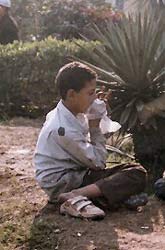Egypt: Street children and substance abuse
Children living and working on the streets are vulnerable to violence, exploitation and substance abuse. Many turn to drugs to cope with their stressful and precarious lives.
 Egyptian law defines them as "children exposed to delinquency." Many people, including police officers, simply see them as criminals.
Egyptian law defines them as "children exposed to delinquency." Many people, including police officers, simply see them as criminals.
To NGOs and researchers, however, street children are victims rather than criminals. In contrast to the definition provided in Egypt's 1996 Child Law, they consider street children to be minors who spend most of their time on the street without protection or guidance. Generally, they have little or no contact with their families.
Despite the difficulties in identifying street children, enough information is available to help us understand what forced them onto the streets. Poverty, unemployment, family breakdown, child abuse and neglect are the main factors that cause minors to roam the streets of Cairo, Giza and other Egyptian cities. Precise numbers are not available but Egyptian experts estimate that between 200,000 and one million children are on the streets, often doing whatever it takes to survive.
To cope with their day-to-day problems, some street children resort to substance abuse. Studies carried out in Egypt indicate that inhalants top the list of drugs consumed. Children sniff glue to deal with the hunger, pain and violence they are exposed to on the streets. Glue is preferred because it is cheap, its effects are long-lasting and its withdrawal symptoms are mild. Glue is usually consumed in groups. Many youngsters also consume tobacco, cannabis and over-the-counter drugs. They are generally unaware of or indifferent to the numerous risks connected to substance abuse.
 Dealing with street children requires efforts from Government, civil society and the children themselves. Clear and comprehensive policies are needed. With this in mind, in 2004 the Egyptian Government launched its National Strategy to Protect and Rehabilitate Street Children. The strategy is based on the principle that these children are victims who need support to be reintegrated into society. Government institutions, NGOs, UNODC and others have come together to make this happen. The National Council for Childhood and Motherhood coordinates joint efforts throughout Egypt. Reception centres have been established to protect and rehabilitate street children, as well as a hotline for children at risk and on the streets, and a database to compile reliable data.
Dealing with street children requires efforts from Government, civil society and the children themselves. Clear and comprehensive policies are needed. With this in mind, in 2004 the Egyptian Government launched its National Strategy to Protect and Rehabilitate Street Children. The strategy is based on the principle that these children are victims who need support to be reintegrated into society. Government institutions, NGOs, UNODC and others have come together to make this happen. The National Council for Childhood and Motherhood coordinates joint efforts throughout Egypt. Reception centres have been established to protect and rehabilitate street children, as well as a hotline for children at risk and on the streets, and a database to compile reliable data.
UNODC pays special attention to protecting street children from drugs. The Office has trained social workers in the treatment and rehabilitation of children abusing drugs. Workshops have also been organized to improve police officers' understanding of the problem and to change the image they have of these vulnerable young people. The goal is to give Egyptian street children the chance of a better future.
Faisal Hegazy and Noha Chakkal from the UNODC Regional Office for the Middle East and North Africa and Nashaat Hussein contributed to this report.
|
Who are street children? In developed countries, street children are as young as 8 years old and girls are a minority. In developing countries, street children are usually teenagers and half of them are girls.
Source: World Health Organization |